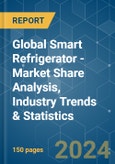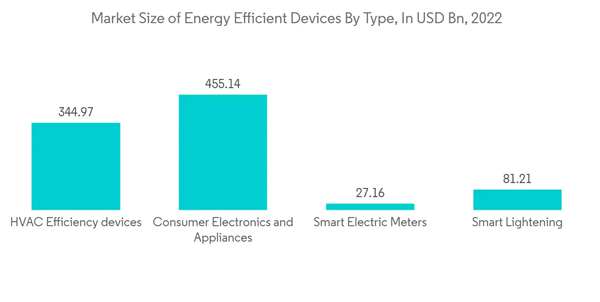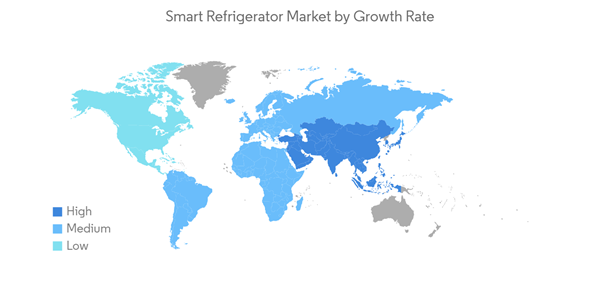The Global Smart Refrigerator Market size is estimated at USD 3.61 billion in 2024, and is expected to reach USD 4.22 billion by 2029, growing at a CAGR of 3.14% during the forecast period (2024-2029).
An increase in the use of the Internet of Things (IoT) and rapid urbanization drive the growth of the global smart connected refrigerator industry. Moreover, the rise in disposable income of people and the increase in efficiency of smart connected refrigerators, such as the use of less electricity, were expected to boost market growth. The smart refrigerator offers connectivity with search engines, smart speakers, and other smart technologies, providing enhanced convenience and efficiency to the users and supporting market trends. The changing consumer lifestyles and shift toward purchasing advanced smart home products, supported by increased disposable income, will boost market demand. The easy availability of intelligent appliances and the growing knowledge of consumers in developing countries will support product demand. Moreover, the architectural developments in new residences and the need for intelligent products to support aesthetics are transforming the market outlook.
The growth in Smart Refrigerator Machines is mainly due to the companies resuming their operations and adapting to the new normal while recovering from the COVID-19 impact, which had earlier led to restrictive containment measures involving social distancing, remote working, and the closure of commercial activities that resulted in operational challenges.
With growing urbanization in the world economy, mostly in developed countries, there is an increasing demand for IoT (the Internet of Things) and smart devices. Countries like India, where the working population has grown larger than the dependent population. This reduces the dependency rate to less than 50% and increases disposable income, which ultimately boosts the smart refrigerator market.
As food retailers look to reduce energy bills, every incremental savings counts. Increasing price competition means operating costs have an immediate impact on competitiveness and profitability-and, after staff, energy is the biggest bill most supermarkets have. In food retail, most of that energy is spent on refrigeration, so efficient new components, like the AKVP electric expansion valve and high-end case controllers, are usually a good investment.
The introduction of smart appliances that utilize IoT is reshaping the smart appliance industry.In the past few years, there have been a number of improvements to smart refrigerators, which have made them better at being sustainable.
In terms of retail value, Asia had the largest retail value of refrigerator appliances in 2022, followed by North America and Europe.
The Asia-Pacific region has the most price-sensitive customers, forcing companies to use promotional techniques like Black Friday specials, holiday sales, and additional online deals to boost sales of smart refrigerators.
This product will be delivered within 2 business days.
An increase in the use of the Internet of Things (IoT) and rapid urbanization drive the growth of the global smart connected refrigerator industry. Moreover, the rise in disposable income of people and the increase in efficiency of smart connected refrigerators, such as the use of less electricity, were expected to boost market growth. The smart refrigerator offers connectivity with search engines, smart speakers, and other smart technologies, providing enhanced convenience and efficiency to the users and supporting market trends. The changing consumer lifestyles and shift toward purchasing advanced smart home products, supported by increased disposable income, will boost market demand. The easy availability of intelligent appliances and the growing knowledge of consumers in developing countries will support product demand. Moreover, the architectural developments in new residences and the need for intelligent products to support aesthetics are transforming the market outlook.
The growth in Smart Refrigerator Machines is mainly due to the companies resuming their operations and adapting to the new normal while recovering from the COVID-19 impact, which had earlier led to restrictive containment measures involving social distancing, remote working, and the closure of commercial activities that resulted in operational challenges.
With growing urbanization in the world economy, mostly in developed countries, there is an increasing demand for IoT (the Internet of Things) and smart devices. Countries like India, where the working population has grown larger than the dependent population. This reduces the dependency rate to less than 50% and increases disposable income, which ultimately boosts the smart refrigerator market.
Smart Refrigerator Market Trends
Rising Demand For Energy Efficient Refrigerators Driving the Market
Smart refrigerator makers are working quickly to make models that use less energy so they can reduce their carbon footprint and save consumers money on their energy bills.The rise of energy-efficient appliances can be traced to both government rules about electric home appliances and advances in technology.Energy-efficient appliances are made to do their job with the least amount of energy possible.Over 80 countries already have energy-efficient appliance regulations and labeling.As food retailers look to reduce energy bills, every incremental savings counts. Increasing price competition means operating costs have an immediate impact on competitiveness and profitability-and, after staff, energy is the biggest bill most supermarkets have. In food retail, most of that energy is spent on refrigeration, so efficient new components, like the AKVP electric expansion valve and high-end case controllers, are usually a good investment.
The introduction of smart appliances that utilize IoT is reshaping the smart appliance industry.In the past few years, there have been a number of improvements to smart refrigerators, which have made them better at being sustainable.
In terms of retail value, Asia had the largest retail value of refrigerator appliances in 2022, followed by North America and Europe.
Asia Pacific Region Driving The Market
The Asia-Pacific market is expected to expand at the fastest rate over the forecast period, as smart connected refrigerator machines have gained popularity owing to their compatibility and user-friendliness features. Furthermore, the market expansion is fueled by rising urbanization and an expanding middle-class population. The presence of important market participants in the region also helps to support the development of innovative products to expand the customer base. Product demand in this region is expected to be fueled by rising internet penetration and technological improvements in developing economies such as China and India. In India, the average rate of IoT penetration is in the single digits, whereas the global average rate is in the double digits. This creates a huge opportunity for the smart refrigerator machine industry to flourish in Asia Pacific's growing economies.The Asia-Pacific region has the most price-sensitive customers, forcing companies to use promotional techniques like Black Friday specials, holiday sales, and additional online deals to boost sales of smart refrigerators.
Smart Refrigerator Industry Overview
This market has many companies fragmented over minor shares. Companies are focusing on expanding their product lines through product innovation, particularly in developing economies, to meet the rising demand. Some of the major players in the smart refrigerator market are Samsung, LG Electronics, Whirlpool Corporation, Haier Group, Robert Bosch GmbH, Siemens AG, GE Appliances, AB Electrolux, Panasonic Corporation, and others.Additional Benefits:
- The market estimate (ME) sheet in Excel format
- 3 months of analyst support
This product will be delivered within 2 business days.
Table of Contents
1 INTRODUCTION
4 MARKET DYNAMICS AND INSIGHTS
5 MARKET SEGMENTATION
6 COMPETITIVE LANDSCAPE
Methodology

LOADING...










